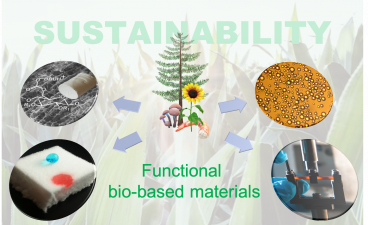
Véronique Coma
Associate professor

In the current context of sustainability, biopolymers are increasingly considered for the elaboration of novel functional materials with tailored properties. Indeed, in many cases, their renewability comes with valuable characteristic features such as biocompatibility, bioactivity, barrier properties, self-organization ability, etc. For this reason, they can be envisioned as valuable building blocks in the elaboration of functional materials with applications in areas as diverse as biotechnology, electronics, optics, energy, packaging or catalysis. In this perspective, polysaccharides are important biopolymers because of their high abundance, wide distribution and low cost of production. Our group is actively contributing to the valorization of these naturally occurring polymers, notably nanocellulose and chitosan.
We have a recognized expertise for the chemical functionalization of nanocellulose particles surface, using reactions based on alcohol chemistry. We developed different strategies – e.g. acylation, silylation, or polymer grafting - to produce nanocellulose particles with various tailored surface properties, which could find application in different domains. In particular, we illustrated the utility of functional nanocelluloses as reinforcing and barrier agents in nanocomposites [1], Pickering emulsifiers [2], porous scaffolds [1,3], or catalyst supports [4].
 Our know-how lays also in biodegradable and active polysaccharide-based materials (PBMs). In particular, we use chitosans as carriers for antimicrobials or antioxidants and created chitosan-based matrices suitable for the long-term release of bioactive substances [5, 6]. These alternative biodegradable materials are increasingly attractive especially in the biopackaging, biopesticide and biomedical fields.
Our know-how lays also in biodegradable and active polysaccharide-based materials (PBMs). In particular, we use chitosans as carriers for antimicrobials or antioxidants and created chitosan-based matrices suitable for the long-term release of bioactive substances [5, 6]. These alternative biodegradable materials are increasingly attractive especially in the biopackaging, biopesticide and biomedical fields.

[1] Z. Zhang, P. Tingaut, D. Rentsch, T. Zimmermann, G. Sèbe, ChemSusChem, 8, 2681 (2015)
[2] Z. Zhang, K. C. Tam, X. Wang, G. Sèbe, ACS Sustain. Chem. Eng., 6, 2583 (2018)
[3] G. Chantereau, N. Brown, M.-A. Dourges, C. S. R. Freire, A. J. D. Silvestre, G. Sebe, V. Coma, Carbohydr. Polym., 220, 71, (2019)
[4] Z. Zhang, G. Sèbe, X. Wang, K. C. Tam, Carbohydr. Polym., 182, 61 (2018).
[5] I. Fernández-pan, J. I. Maté, C. Gardrat, V. Coma, Food Hydrocolloids, 51, 60-68 (2015)
[6] A. Zimoch-korzycka, C. Gardrat, M. Al Kharboutly, A. Castellan, I. Pianet, A. Jarmoluk, V. Coma, Food Hydrocolloids, 61, 338-343 (2016)